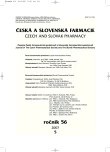Abiotic elicitation of Trifolium pratense L. Suspension culture
Abiotická elicitace suspenzní kultury Trifolium pratense L.
Mezi významné látky sekundárního metabolismu patří flavonoidy a isoflavonoidy. Suspenzní kultura Trifolium pratense L. (Fabaceae) má však nízkou produkci těchto metabolitů, a proto byla snaha ovlivnit její elicitací. Podle původu se elicitory rozdělují na biotické a abiotické elicitory, mezi které lze zařadit např. soli těžkých kovů. Cílem práce bylo sledovat vliv abiotického elicitoru síranu měďnatého na produkci suspenzní kultury Trifolium pratense L. (varieta DO-8 a varieta DO-9), která byla kultivovaná na mediu podle Gamborga s přídavkem 2 mg.l⁻¹ 2,4-dichlorfenoxyoctové kyseliny a 2 mg.l⁻¹ 6-benzylaminopurinu. Maximální zvýšení produkce flavonoidů oproti kontrole vyvolala u obou variet 168hodinová aplikace koncentrace 100 μmol. Produkci isoflavonoidů u variety DO-8 stimulovala zejména 48hodinová aplikace koncentrace 1 μmol, u variety DO-9 měla největší elicitační účinek 168hodinová aplikace koncentrace 10 μmol.
Klíčová slova:
suspenzní kultura Trifolium pratense L. – flavonoidy a isoflavonoidy – abiotická elicitace – těžké kovy
Authors:
M. Kašparová; T. Siatka; J. Dušek
Authors‘ workplace:
Charles University in Prague, Faculty of Pharmacy in Hradec Králové, Department of Pharmacognosy
Published in:
Čes. slov. Farm., 2007; 56, 225-229
Category:
Original Articles
Overview
Important substances of secondary metabolism include flavonoids and isoflavonoids. The Trifolium pratense L. (Fabacae) suspension culture is characterized by low production of these metabolites and therefore we tried to influence the production output with elicitation. From their origin point of view, the elicitors are divided into two groups – biotic and abiotic. The latter group includes, for instance, the salts of heavy metals. Our work was aimed at observing the effect of the copper sulphate abiotic elicitor on the production of the Trifolium pratense L. suspension culture (variety DO-8 and variety DO-9) that was cultivated in Gamborg media supplemented with 2 mg.l⁻¹ of 2,4-dichlorophenoxyacetic acid and 2 mg.l⁻¹ of 6-benzylaminopurine. The maximum increase in the flavonoid production took place, when compared with the test check, during the 168-hour application of the 100 μmol concentration.
The DO-8 variety isoflavonoids production was stimulated namely during the 48-hour application of the 1 μmol concentration; the best elicitation effect of the DO-9 variety was achieved with the 168-hour application of the 10 μmol concentration.
Key words:
Trifolium pratense L. suspension culture – flavonoids and isoflavonoids – abiotic elicitation – heavy metals
Labels
Pharmacy Clinical pharmacologyArticle was published in
Czech and Slovak Pharmacy

2007 Issue 5
Most read in this issue
- Mucoadhesive tablets for oral administration of ciclopiroxolamine
- Oxidative stress and its role in respiratory diseases
- Cytochrome P450 3A polymorphism and its importance in cyclosporine and tacrolimus therapy in transplanted patients
- Determination of valproic acid by on-line coupled capillary isotachophoresis with capillary zone electrophoresis with conductometric detection
